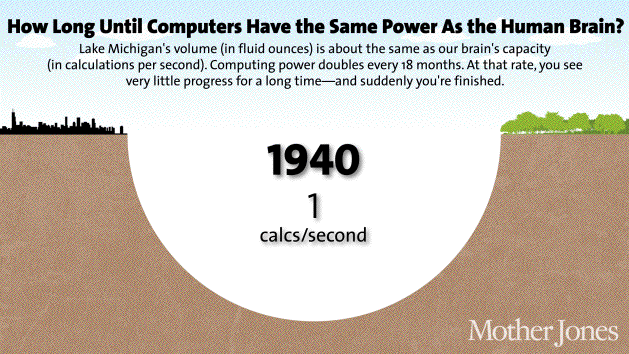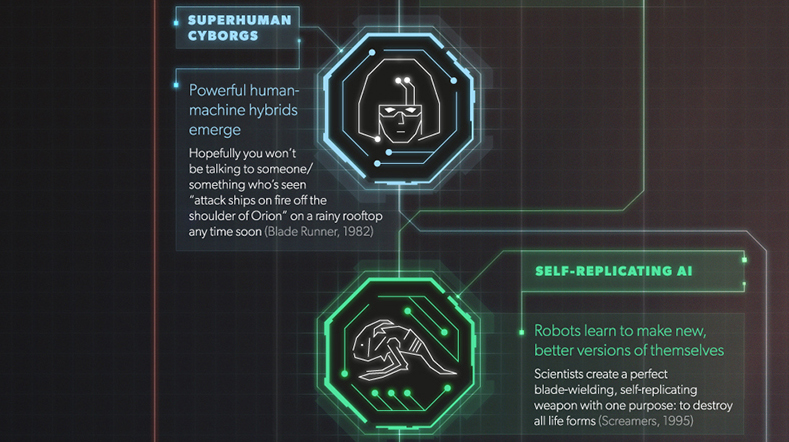Technology
The Future of Artificial Intelligence, According to Pop Culture
The unpredictable nature of superintelligent, self-improving machines lends itself quite nicely to the dramatic storylines of movies and books.
It’s a science fiction writer’s dream: if AI becomes smart enough to create more advanced versions of itself, pretty much every outcome is on the table. Machines could empower humanity to become enlightened and virtuous. On the less optimistic side? Machines could instead ruthlessly enslave all of humankind to tickle their own warped sense of satisfaction.
Pop Culture Perspectives
From the plot of movies like The Terminator to The Matrix, pop culture offers up innumerable examples of what could happen from the rise of the machines – and most of them, as you can imagine, steer towards the less optimistic side of the spectrum.
Today’s infographic from BBC Future provides an entertaining take on these scenarios, organized by potential likelihood.
Note: Infographic removed at request of BBC. To see it, click link above – or see our other AI infographic here.
Some experts see AI having a $15.7 trillion impact on our economy, but pop culture offers up a slightly different perspective of what the future may hold.
Future AI Scenarios
Here are just some of the scenarios offered up in mainstream movies, books, and television shows. Some are apocalyptic and dystopian, and some seem just plain bizarre:
Seductive Siris: In 2013’s Her, Joaquin Phoenix falls in love with an intelligent operating system named Samantha.
Self-Replicating AI: In 1995’s Screamers, scientists create a self-replicating weapon with one purpose: to destroy all life.
The Singularity: AI vies to take over the world in 1982’s classic Tron.
Rampaging Robots: In 1973’s Westworld, recently re-envisioned as a different TV series by HBO, murderous androids go on a killing spree in a futuristic Disney-style theme park.
Feeling Machines: In the 1999 movie Bicentennial Man, a household robot experiences emotions, creative thoughts, and eventually develops sentience.
Androids Among Us: Artificial beings infiltrate society undetected in TV series Battlestar Galactica.
Human Enslavement: In the 1999 movie The Matrix, all life on Earth is an elaborate facade. The robots are really the ones in command, but you wouldn’t know it until you take the “red pill”.
Mind Upload: Digitized humans gain immortality and then wreak havoc, such as in 2014’s Transcendence.
One Certainty
While some of these ideas seem far-fetched, it’s worth noting that not all future scenarios are as distant as they may seem.
With computing power increasing exponentially, the tail end of the hockey stick could happen sooner than we may think.

Technology
Ranked: Semiconductor Companies by Industry Revenue Share
Nvidia is coming for Intel’s crown. Samsung is losing ground. AI is transforming the space. We break down revenue for semiconductor companies.
Semiconductor Companies by Industry Revenue Share
This was originally posted on our Voronoi app. Download the app for free on Apple or Android and discover incredible data-driven charts from a variety of trusted sources.
Did you know that some computer chips are now retailing for the price of a new BMW?
As computers invade nearly every sphere of life, so too have the chips that power them, raising the revenues of the businesses dedicated to designing them.
But how did various chipmakers measure against each other last year?
We rank the biggest semiconductor companies by their percentage share of the industry’s revenues in 2023, using data from Omdia research.
Which Chip Company Made the Most Money in 2023?
Market leader and industry-defining veteran Intel still holds the crown for the most revenue in the sector, crossing $50 billion in 2023, or 10% of the broader industry’s topline.
All is not well at Intel, however, with the company’s stock price down over 20% year-to-date after it revealed billion-dollar losses in its foundry business.
| Rank | Company | 2023 Revenue | % of Industry Revenue |
|---|---|---|---|
| 1 | Intel | $51B | 9.4% |
| 2 | NVIDIA | $49B | 9.0% |
| 3 | Samsung Electronics | $44B | 8.1% |
| 4 | Qualcomm | $31B | 5.7% |
| 5 | Broadcom | $28B | 5.2% |
| 6 | SK Hynix | $24B | 4.4% |
| 7 | AMD | $22B | 4.1% |
| 8 | Apple | $19B | 3.4% |
| 9 | Infineon Tech | $17B | 3.2% |
| 10 | STMicroelectronics | $17B | 3.2% |
| 11 | Texas Instruments | $17B | 3.1% |
| 12 | Micron Technology | $16B | 2.9% |
| 13 | MediaTek | $14B | 2.6% |
| 14 | NXP | $13B | 2.4% |
| 15 | Analog Devices | $12B | 2.2% |
| 16 | Renesas Electronics Corporation | $11B | 1.9% |
| 17 | Sony Semiconductor Solutions Corporation | $10B | 1.9% |
| 18 | Microchip Technology | $8B | 1.5% |
| 19 | Onsemi | $8B | 1.4% |
| 20 | KIOXIA Corporation | $7B | 1.3% |
| N/A | Others | $126B | 23.2% |
| N/A | Total | $545B | 100% |
Note: Figures are rounded. Totals and percentages may not sum to 100.
Meanwhile, Nvidia is very close to overtaking Intel, after declaring $49 billion of topline revenue for 2023. This is more than double its 2022 revenue ($21 billion), increasing its share of industry revenues to 9%.
Nvidia’s meteoric rise has gotten a huge thumbs-up from investors. It became a trillion dollar stock last year, and broke the single-day gain record for market capitalization this year.
Other chipmakers haven’t been as successful. Out of the top 20 semiconductor companies by revenue, 12 did not match their 2022 revenues, including big names like Intel, Samsung, and AMD.
The Many Different Types of Chipmakers
All of these companies may belong to the same industry, but they don’t focus on the same niche.
According to Investopedia, there are four major types of chips, depending on their functionality: microprocessors, memory chips, standard chips, and complex systems on a chip.
Nvidia’s core business was once GPUs for computers (graphics processing units), but in recent years this has drastically shifted towards microprocessors for analytics and AI.
These specialized chips seem to be where the majority of growth is occurring within the sector. For example, companies that are largely in the memory segment—Samsung, SK Hynix, and Micron Technology—saw peak revenues in the mid-2010s.
-

 Real Estate2 weeks ago
Real Estate2 weeks agoVisualizing America’s Shortage of Affordable Homes
-

 Technology1 week ago
Technology1 week agoRanked: Semiconductor Companies by Industry Revenue Share
-

 Money1 week ago
Money1 week agoWhich States Have the Highest Minimum Wage in America?
-

 Real Estate1 week ago
Real Estate1 week agoRanked: The Most Valuable Housing Markets in America
-

 Business2 weeks ago
Business2 weeks agoCharted: Big Four Market Share by S&P 500 Audits
-

 AI2 weeks ago
AI2 weeks agoThe Stock Performance of U.S. Chipmakers So Far in 2024
-

 Misc2 weeks ago
Misc2 weeks agoAlmost Every EV Stock is Down After Q1 2024
-

 Money2 weeks ago
Money2 weeks agoWhere Does One U.S. Tax Dollar Go?














